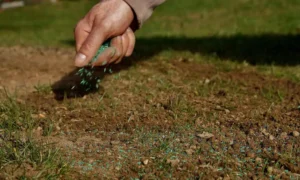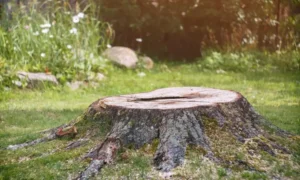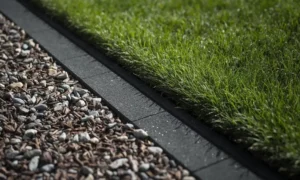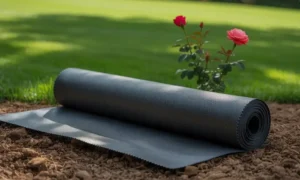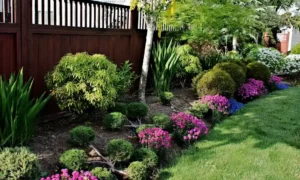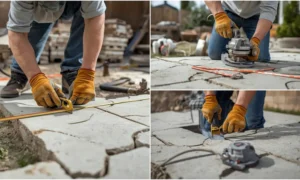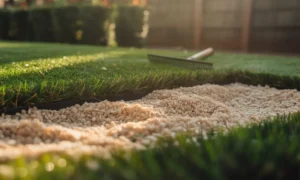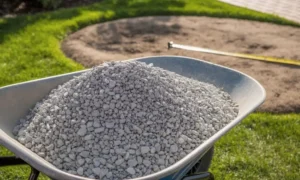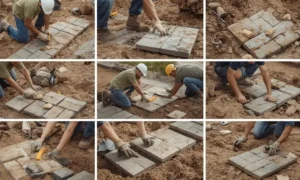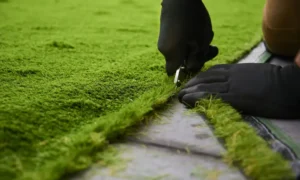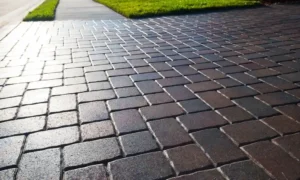How to lay artificial turf is a practical solution for creating a lush, green lawn without the upkeep of natural grass. It’s ideal for homes, businesses, and play areas, offering durability and year-round curb appeal. When installing artificial grass, proper preparation and placement are essential for long-term performance. A poorly done job can lead to drainage issues, uneven surfaces, or turf that lifts over time. Whether you’re laying artificial grass on soil or concrete, following the right steps ensures a clean, natural look. This guide covers everything from surface prep to cost-saving tips. You’ll also learn how to install artificial grass correctly. Let’s make your turf installation smooth and successful.
Tools and Materials Needed
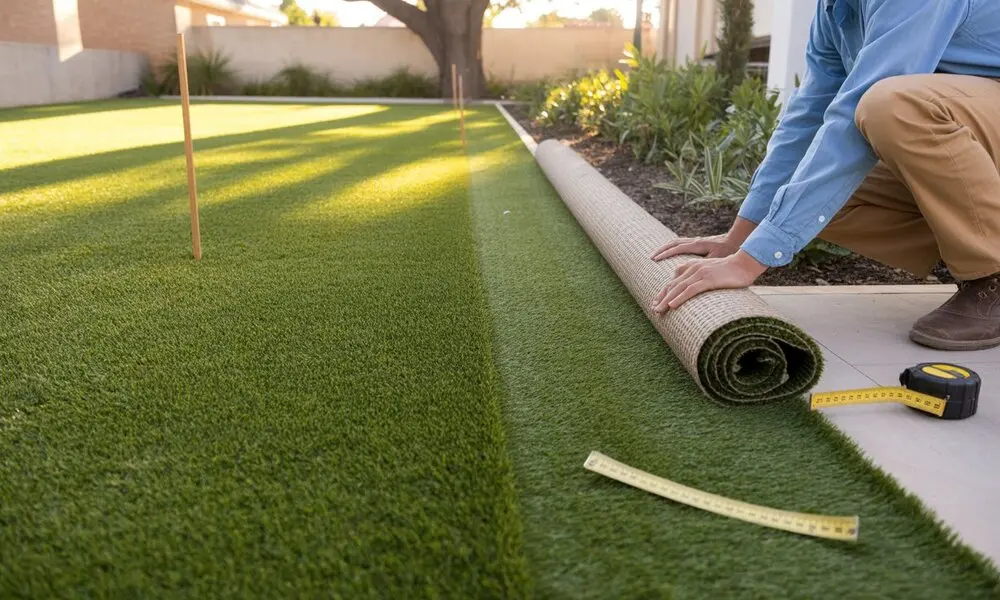
Before starting your synthetic turf installation, gather all the necessary materials and tools to ensure a smooth process. Here’s what you’ll need:
- Synthetic Turf: Choose high-quality turf that fits your project’s look and feel.
- Base Material: Crushed rock or decomposed granite is ideal for a stable foundation.
- Weed Barrier Fabric: Aids in keeping weeds from growing beneath the turf.
- Turf Adhesive or Nails: Vital for holding the lawn in place while it is being installed.
- Infill Material: Use silica sand or rubber granules to keep the turf blades upright and improve durability.
- Tools: A utility knife for cutting turf, a turf rake for spreading infill, and a compactor for leveling the base.
Properly preparing with the right tools and materials is key to successful laying synthetic turf and ensuring a long-lasting synthetic turf installation.
How to Lay Artificial Turf: Ground Preparation
Thorough ground preparation is the key to a durable and professional-looking synthetic turf installation. Whether you’re laying artificial grass on soil or concrete, each surface requires specific steps for proper installation.
A. For Soil or Natural Ground
- Remove Existing Grass and Weeds
Start by digging out grass, roots, and weeds from the installation area. Remove about 3–4 inches of topsoil to make room for the base material. - Grade and Level the Soil
Smooth and slightly grade the area to allow for water drainage. Ensure the ground is even to avoid bumps or low spots under the turf. - Install Weed Barrier
Roll out a weed barrier fabric over the graded soil. This lets water drain properly and stops weeds from growing. - Add and Compact Base Layer
Cover with 2 to 3 inches of crushed rock or broken granite. For a stable and even surface on which to install fake grass, use a plate compactor to compact the base firmly.
B. For Concrete Surfaces
- Clean and Dry the Concrete
Sweep the surface thoroughly and wash away any debris or dirt. Make sure the concrete is completely dry before continuing. - Apply Drainage Holes if Needed
Drill small drainage holes every few feet if the concrete has poor water runoff. This prevents water from pooling under the turf, which can lead to mildew or odors. - Use Adhesive for Turf Installation
Line the center and edges of the concrete surface with double-sided turf tape or outdoor turf adhesive. Carefully roll out the turf and press it down firmly, ensuring there are no air pockets.
With the ground properly prepped, your synthetic turf installation will not only look great but also last longer. Taking the time for detailed groundwork is essential when installing artificial grass on any surface.
You may read about How Much To Water New Turf.
How To Install Artifical Grass
After thoroughly preparing the ground, the next crucial phase in how to install artificial grass is laying down the turf with care and precision. Proper installation guarantees both durability and a natural appearance.
- Roll Out and Acclimate Turf
Begin by unrolling the synthetic turf across the prepared surface. Allow the turf to acclimate by letting it rest for several hours, ideally overnight. This helps the turf fibers relax and any creases or wrinkles from packaging to flatten out, making it easier to handle and shape. - Trim to Fit the Area
Trim the turf’s edges carefully with a sharp utility knife or turf cutter to match the precise measurements and shapes of your area. Work gently and measure twice before cutting to ensure clean, accurate edges. For curved or irregular shapes, make small cuts and adjustments as needed to maintain a seamless fit. - Seam Pieces Together (if Needed)
Lay the sections of turf side by side with the grass fibers pointing in the same direction if your project calls for more than one piece. Use high-quality seam tape beneath the edges where the pieces meet.Cover the tape with grass adhesive, firmly press the edges together, and let it cure. Properly joined seams create a continuous, natural-looking lawn without visible gaps or overlaps. - Secure Edges with Nails or Glue
To keep the turf firmly in place, secure the perimeter using galvanized landscaping nails or staples, spaced about every 6 to 8 inches. For concrete or hard surfaces, apply a strong outdoor-grade adhesive along the edges and at any seams. Press the turf down firmly to ensure a tight bond. Securing the edges prevents shifting, curling, or lifting over time. - For a more natural appearance, brush up the turf fibers.
After installing and securing the turf, brush the grass fibers upright with a stiff-bristled broom or a specialist turf rake. This lifts flattened blades, improves texture, and restores the natural appearance of real grass. Brushing also helps evenly distribute any infill material, enhancing the turf’s durability and comfort underfoot.
By following these detailed steps, your synthetic turf installation will look seamless, feel natural, and stand the test of time. For expert artificial turf installation services in the Bay Area, trust none other than Lakota Design Group—your local specialists in transforming outdoor spaces with precision and care.
Cost Breakdown: How Much Does It Cost to Lay Artificial Turf?
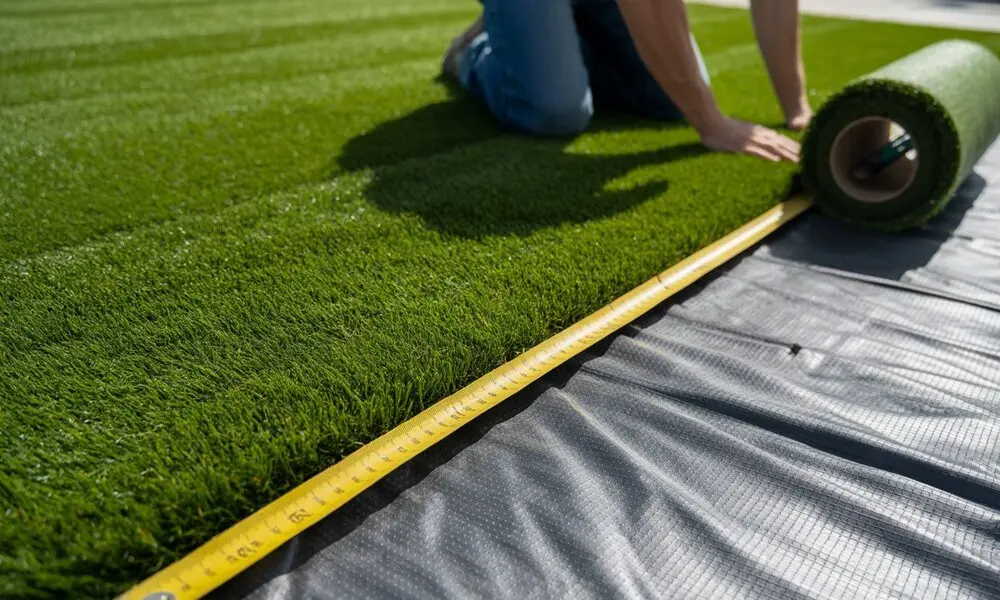
If you’re wondering how much does it cost to lay artificial turf, the total depends on several factors, including materials, labor, project size, and installation method. Here’s a detailed breakdown:
Average Cost per Square Foot (Materials + Labor)
The national average cost for laying artificial turf ranges from $5 to $20 per square foot, depending on the turf quality and complexity of the installation.
- Basic synthetic turf: $2–$5 per sq. ft.
- Higher-end turf (more realistic, durable): $6–$10 per sq. ft.
- Installation labor: $4–$8 per sq. ft.
- Total (materials + labor): $8–$20 per sq. ft.
DIY vs. Professional Installation
- DIY Installation:
If you’re handy and have the time, you could save on labor costs by installing artificial grass yourself. You’ll still need to rent or buy tools like a compactor and cutter. Expect DIY costs to fall between $3–$10 per sq. ft., depending on material and equipment needs. - Professional Installation:
Hiring a contractor ensures expert-level results, especially for large or complex spaces. It reduces errors and saves time. This route is ideal for long-term durability and includes all groundwork, leveling, and cleanup.
Cost-Saving Tips and Variables
- Project Size: Larger areas often benefit from volume discounts on materials and labor.
- Turf Type: Choose a turf that balances quality and budget; not all expensive options are necessary for light foot traffic.
- Site Conditions: More grading, demolition, or prep increases labor costs.
- Off-season Discounts: Schedule installations during slower months for possible price reductions.
- DIY Prep: Even if hiring pros, handling the demolition or base prep yourself can reduce the total cost.
Understanding the full cost of synthetic turf installation helps you plan your project wisely. Whether you’re going the DIY route or hiring experts, clear budgeting ensures a successful and cost-efficient turf transformation.
Cheapest Way to Lay Artificial Grass
If you’re looking for the cheapest way to lay artificial grass, there are smart, budget-friendly strategies that can help you cut costs without sacrificing quality. Here’s how to install turf affordably—especially if you’re taking the DIY route.
1. Use Recycled or Inexpensive Base Materials
Instead of premium crushed granite, consider using recycled road base, crushed concrete, or class II base rock from local supply yards. These materials are more affordable and still provide a solid, compacted foundation when properly installed.
2. Buy Turf Remnants or Offcuts
Many turf suppliers sell remnant rolls or offcuts at steep discounts—ideal for small or irregular-shaped areas. These are leftover pieces from large projects and often come at 30–50% less than full-priced turf.
3. DIY Installation vs. Hiring Help
The most significant savings come from doing it yourself. DIY means avoiding labor costs, which can make up nearly half the total expense. You’ll need to handle tasks like ground prep, cutting, and securing the turf, but with basic tools and online tutorials, it’s very achievable.
Pro Tip: If full DIY isn’t ideal, consider partial DIY—prep the ground yourself and hire pros only for turf laying and finishing.
4. Long-Term Savings vs. Upfront Investment
While upfront costs matter, synthetic turf installation offers long-term savings on water bills, lawn care equipment, fertilizers, and maintenance. Budget-friendly doesn’t mean cutting corners—just smarter choices that stretch your dollar.
Final Thoughts
Knowing how to lay artificial turf properly is key to achieving a clean, low-maintenance lawn that lasts for years. From ground preparation to trimming and securing the turf, every step matters in creating a seamless, natural look. Whether you’re tackling a DIY project or considering professional help, planning and using quality materials will make all the difference. If you need assistance with synthetic turf installation or want expert results without the hassle, Lakota Design Group is here to help. We specialize in professional landscape solutions tailored to your needs. Contact us today to get started on your artificial turf project and transform your outdoor space with ease!
FAQs
Q1: What Tools Are Needed To Lay Artificial Turf?
To properly lay artificial turf, you’ll need tools like a utility knife, turf rake, compactor, shovel, wheelbarrow, landscape nails, adhesive, and a stiff broom. These ensure accurate cutting, leveling, and securing of the turf for long-term performance.
Q2: Can I Lay Artificial Turf Directly On Soil?
No, you shouldn’t install turf directly on soil. The ground needs proper grading, a compacted base layer (such as crushed rock), and a weed barrier to ensure durability and drainage during synthetic turf installation.
Q3: How Do You Join Two Pieces Of Artificial Grass?
Use seam tape and turf adhesive to bond two pieces of turf. Make sure the grass blades face the same direction, align the edges closely, and press down firmly to create a seamless finish when installing artificial grass.
Q4: How Do I Secure The Edges Of Artificial Turf?
Edges can be secured with galvanized landscape nails for soil-based surfaces or outdoor turf adhesive for concrete. Securing edges prevents lifting and keeps the turf in place over time.
Q5: Does Artificial Turf Need Infill?
Yes, most turf installations require infill such as silica sand or rubber granules. Infill supports the turf blades, improves appearance, enhances drainage, and adds weight to hold the turf in place.


